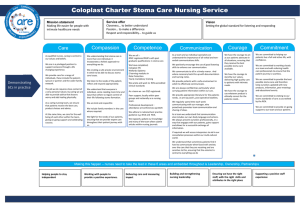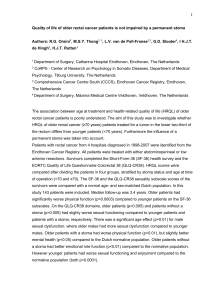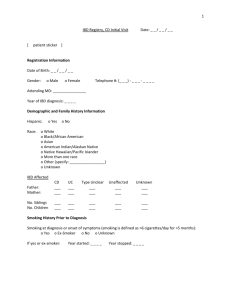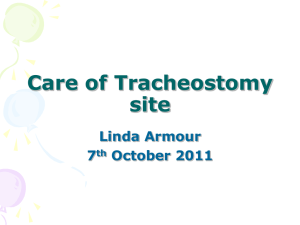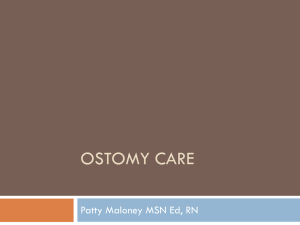Discussion Paper - Department of Health
advertisement
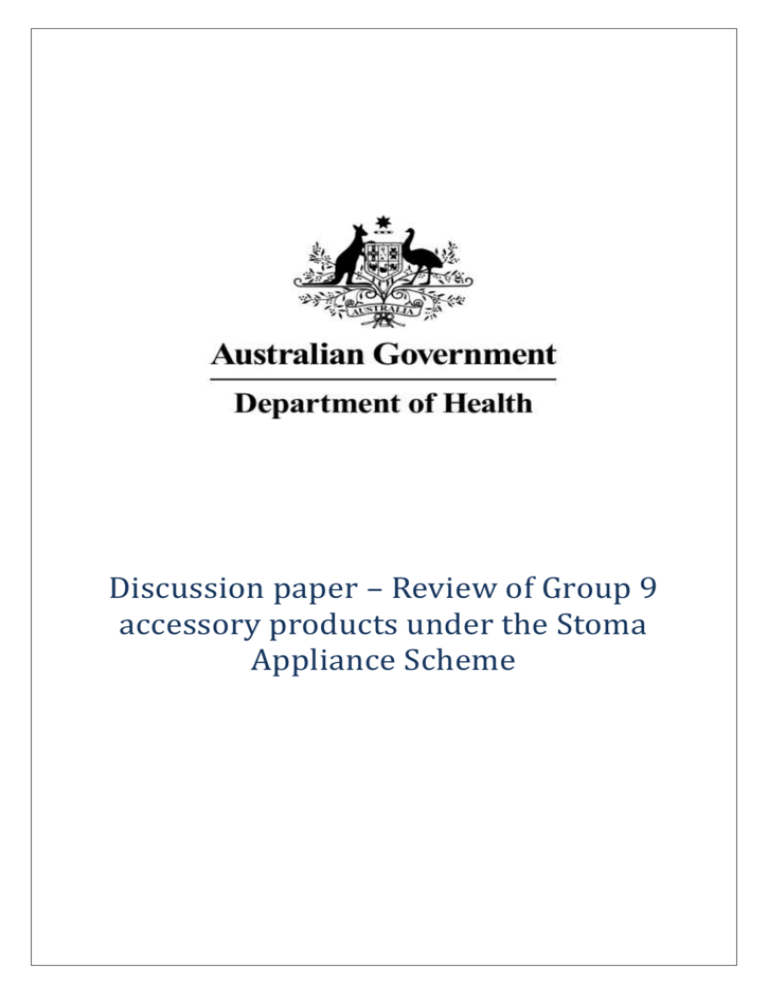
Discussion paper – Review of Group 9 accessory products under the Stoma Appliance Scheme Table of Contents Introduction ......................................................................................................................................................... 3 The Review to Date ............................................................................................................................................. 4 Clinical and consumer experience in the use of Group 9 products..................................................................... 6 Guiding questions for the Review of Group-9 Products.................................................................................... 12 Public submissions process ............................................................................................................................... 13 Page | 2 Introduction The Stoma Appliance Scheme (SAS/the Scheme), established in 1975 and subsidised by the Australian Government, provides support to people with a stoma by improving access to the most suitable and clinically appropriate stoma related products. A stoma is a temporary or permanent body opening, either natural or surgically created, which connects a portion of the body cavity to the outside environment to allow bodily waste to leave the body. The point of exit, or stoma, needs to be covered with a removable pouching system (adhesive or mechanical) to collect and contain the output for later disposal. Products supplied under the Scheme assist people with stomas to better manage their condition, and allow greater participation in society and the workforce. These products are provided free of charge to members of 22 regional stoma associations across Australia. During 2012-13, approximately 41,000 people with stomas accessed SAS through approved volunteer stoma associations. Members of associations can access products without a direct co-payment for each product; the only payment required for products is a yearly membership fee. These stoma associations purchase stoma related products from suppliers and distribute to their members when products are ordered, generally monthly. Stoma associations then claim the cost of stoma products from the Department of Human Services. An administration fee is paid to stoma associations, in addition to the cost of products, to account for distribution costs. There are set maximum quantities of each type of product available per month to people with stomas. In the 2012-13 Budget, the Government agreed to reviews of products supplied under the SAS; specifically, reviews of: maximum monthly quantities of products available; product price premiums; and accessory products listed under Group 9 of the SAS Schedule (the Group 9 Review/the Review). The Review of maximum monthly quantities of products available to people with stomas may be informed by the Group 9 Review. The Review of product price premiums has been completed. Group 9 Review The Group 9 SAS Schedule classification broadly covers accessories used by patients with a stoma. Specifically this classification includes; adhesive barriers, belts, clamps and clips, cleansers and solvents, convexity inserts, creams and ointments, deodorants, support belts and garments, night drainage, powders and pastes, protective films, and seals. Products listed under Group 9 have evidenced significant cost growth over recent years. The Scheme overall has seen growth in costs of 5.74 per cent annually over the period 2007-08 to 2013-14, whereas Group 9 products have grown at 11.01 per cent over the same period. Group 9 products now also represent the greatest cost other than for stoma pouches under the Scheme, at approximately one quarter of the cost of the entire Scheme. The objective of the Group 9 Review is to assess the clinical appropriateness of accessory products, their appropriateness to the SAS scheme and the appropriateness of how they are used by people with stomas. As part of this, the Review will determine whether the current pricing and specified Page | 3 maximum quantities for each product are appropriate, and where required, adjust pricing and maximum quantities. Currently there are ‘benchmark’ prices for a range of products under the SAS, which reflects that products of similar categories (for example, stoma pouches) tend to be of similar form and function. It is intended that where possible, notional benchmark products and pricing will be established for each subgroup in Group 9. This Review is being undertaken by the Department of Health working in conjunction with the Stoma Product Assessment Panel (SPAP). The Stoma Product Assessment Panel (SPAP) is an independent technical advice panel appointed by the Department of Health to review applications from suppliers requesting inclusion of a stomarelated product on the SAS Schedule. The panel provides recommendations to Government on whether a product should be listed on the Schedule, and at what price, based on a review of the available evidence to inform a decision on public funding. The responsibility for making decisions on the listing and pricing of products, as well as in relation to the outcomes of this Review, remains a matter for Government. The purpose of this discussion paper is to outline the steps the Department has taken in the Review to date and to seek informed input and advice from peak bodies, professionals and consumers on any future changes to the Group 9 under the Scheme. The Review to Date Economic analysis The Department has undertaken an economic analysis of the cost of stoma and Group 9 products in conjunction with the Stoma Product Assessment Panel. A copy of the economic analysis can be found at the Department’s web site at: This analysis, combined with more recent statistics indicates that: 1 Overall, the Scheme is growing at a significant rate. The average compound annual growth (annual growth) in SAS costs between 2007-08 and 2013-14 is well above the Consumer Price Index (CPI) increases for recent periods (for example, the all groups seasonally adjusted CPI for June 2013 to June 2014 was 3%1). Group 9 accessory costs are growing at an even greater rate than the Scheme. Over the same period, 2007-08 to 2013-14, the annual growth of Group 9 accessory costs was just over 11%. Of the accessory products, the greatest expenditure is on seals. These are products that assist in ensuring the stoma pouch which collects waste is tightly sealed to the body and does not leak excoriating fluids. The next highest cost type of product was adhesive barriers, which perform a similar function, followed by cleansers and solvents. Cleansers and solvents assist Australian Bureau of Statistics, June key figures Page | 4 in removing either fluids as mentioned above or in removing residue on the skin from tapes, seals and other adhesive products. The annual growth in group 9 accessory products is not even across the range of products. Some products – generally those which form a significantly smaller proportion of products funded - actually declined in popularity. Strong growth tends to be reflective of the proportion of money spent on a particular type of product – other than miscellaneous products, the top products by cost were also the top products in terms of annual trend growth in costs. Further breakdowns of costs by product are provided as part of the economic analysis. Respondents are encouraged to review the analysis to inform advice on any potential changes to Group 9 products, maximum quantities and prices. Literature review The Department has also commissioned a literature review, undertaken by the University of Tasmania. A copy of the literature review can be found at the same link. The literature review involved a review and analysis of existing evidence relating to the use of accessory products by people with stomas. The literature review found a small, methodologically limited body of evidence regarding the effectiveness of stoma accessories. As a result, firm conclusions about the effectiveness and costeffectiveness of Group 9 products could not be drawn from the available literature. The level of evidence of included studies was generally low and the quality of included studies in the lierature review was similarly low. Studies were generally not able to be rated against the National Health and Medical Research Council's levels of evidence. The search of 'grey' literature identified some materials of broad relevance to stoma accessories. These materials provided information regarding stoma schemes in other countries including product costs, limits in quantities of Group 9 accessory products supplied to consumers in other countries and guidelines that are in place in other countries to inform use of Group 9 accessories. Guideline developers internationally confirmed the results of the systematic review and noted a paucity of published studies of the effectiveness of stoma accessories. Published guidelines are based largely on the opinions of clinicians in the stoma field rather than on empirical evidence. Further, industry sponsorship of panel members involved in developing guidelines is common and introduces a significant risk of bias in the guideline development process. In the absence of data regarding the effectiveness of accessories, cost-effectiveness of these products could not be assessed. However, the literature review identified that new products are more commonly introduced in the high cost, high growth sub-groups and quickly achieve a significant share of the product market. This was in spite of an absence of published studies in the public domain that demonstrate the effectiveness of the new product. The SAS price of some relatively high cost products exceeds international comparator product costs. The international comparator cost for these products was modelled at $1.9 million less in total than the SAS cost in 2012-13 dollars. Page | 5 The literature review found that overall, limits to product quantities specified in the SAS Schedule are consistent with limits in international schemes. No studies were identified that indicated product limits were inappropriate or had any adverse impact on patient outcomes. Clinical and consumer experience in the use of Group 9 products Background In developing this paper, the Department met with an expert advisory group to seek input on the Review of Group 9 accessory products. The group was formed on the basis that members have current clinical experience in guiding the use of stoma-related products, or consumer experience in ordering and using products under the SAS. The views of the advisory group, and associated suggestions, are provided without prejudice. General comments of the advisory group on Group 9 products There were a number of themes of discussion among the advisory group that in some cases mirrored feedback received through previous consultations with stakeholder groups or themes of the literature review. The advisory group noted that the changing demographic and health status of the population broadly is relevant to the SAS and may provide context for some of the changes to product usage, while not necessarily explaining the disparity in growth rates between the Scheme overall and Group 9 products. The population is ageing, and there are increasing numbers of overweight patients requiring colorectal surgery. Surgical techniques change over time as new methods are explored, and in some cases the resulting stoma may initially need to be managed with additional accessories. This may be reflective of the patient having a stoma under high tension, or a retracted stoma. The advisory group shared strong views that both the initial and ongoing approach to stoma management should be ‘keep it simple’. There were concerns raised (which will be explored further below) in relation to both the overuse and overprescribing of stoma products, as well as the inappropriate use of some products. Anecdotal information from the advisory group suggested that some patients are stockpiling excess products. Some examples of potentially inappropriate use mentioned were: The use of multiple products to ensure pouch adhesion and minimise leakage, which may be unnecessary or actively interfere with other products; for example, the use of a stoma pouch with both an adhesive barrier film and a protective film; or the use of a seal with an adhesive barrier film, which in both cases may create more leakage rather than less; The use of support belts or support garments with some convex pouches, which is contraindicated as it can cause pressure; The use of chemically incompatible products, in some cases products which are manufactured by different companies but used together; The use of deep convex products by some patients where there may not be a clinical indication. Issues caused by poor maintenance such as failure to remove protective films completely, sometimes associated with overuse of these products, which causes a build-up of silicon on the skin and leads to leakage. Page | 6 Advertising of accessory products was raised as a concern by the advisory group. The group considered that patients may be accessing some products based purely on advertising and without reference to the appropriate clinical advice. The group noted that patients may be suffering leakage or skin damage as a result of the types of issues mentioned above. There were questions raised on what types of advertising by manufacturers is appropriate within the limitations of the therapeutic goods regulatory framework. The advisory group commented on the limited availability of stomal therapy nurses and other healthcare professionals to assist with the management of a stoma, particularly after discharge from hospital. The general arrangements for stoma care are that subsequent to surgery, a patient will have their stoma monitored closely by the healthcare team, led by a stomal therapy nurse. During this period the patient will learn how to manage their stoma, be monitored for skincare conditions and be given advice on which products to use and how to use them. In the public health system, a patient will generally have ongoing access to a stomal therapy nurse post discharge. Stomal therapy nurse availability may be limited in the private system, particularly post discharge. There are limited numbers of stomal therapy nurses, and other health professionals may have limited training or experience in the management of a stoma. It was noted that stoma assessment and care is complex and multifaceted, taking into account the patient’s physical condition, ability to self-manage, psychosocial factors and availability of support. In cases where patients move to different locations, or are travelling, expert advice may not be available on referral before patients make choices about which stoma products and accessories to use. For this, and other reasons, patients may be over-ordering significant amounts of products to test each product before committing to ongoing use, as well as ordering inappropriate products. It was mentioned both in discussions with the advisory group and in the literature review that there may be value in further development of relevant patient and professional information and a treatment algorithm for stoma management. Patients who are primarily self-managing their product use may benefit from this proposed treatment algorithm, particularly in cases where the patient is considering using a new product and/or there is limited access to a stomal therapy nurse or other healthcare professional. It was also considered that the use of a consistent treatment algorithm would minimise the amount of ‘just-in-case’ ordering that the group anecdotally reported. There were also concerns raised with the term ‘accessory’ applying to products in this group. The advisory group was concerned that the term may infer the products in the group are unnecessary in the management of a stoma. The group suggested that an alternative term that could be used is ‘additional products’. Discussion of Group 9 products by subgroup 9a – Adhesive Barriers The adhesive barrier subgroup comprises two types of product: tapes and extension flanges, which generally attach to the sides of the stoma pouch to assist with adherence to the skin; and protective sheets which can be used around and under the stoma pouch to protect the skin. These products were considered by the advisory group to be important for the management of some stomas, particularly post discharge when issues of leakage and skin damage are more common. However, the group noted anecdotally that some patients are self-ordering these products when there Page | 7 are changes in their clinical condition. The use of adhesive barriers may not be appropriate in some cases unless other clinical factors are addressed first. In the context of both this subgroup and a number of other subgroups, the advisory group discussed whether there should be changes to the current SAS rules regarding access to these products. It was the advisory group’s views that the initial commencement of use of an adhesive barrier (as well as a number of other subgroups) should involve an authorisation by a stomal therapy nurse or other healthcare professional. There was further discussion about the advisory group’s views on the need for ongoing involvement of healthcare professionals beyond the point of initial commencement of use of a product, such as whenever there is a product change. It was the advisory group’s view that in some cases the involvement of a healthcare professional would be indicated, but that improving patient education may be the best avenue for ensuring appropriate accessory product use beyond the point of initiation on a product. 9b – Belts This subgroup covers products which attach directly to the stoma pouch and hold the pouch to the patient’s body, as distinct from products listed under subgroup 9h which are intended for hernia prevention and support. These products are used with stoma pouches which have belt attachments integrated. The products are sometimes preferred by people who are undertaking sport or physical work, to ensure the stoma pouch remains attached to the body. The advisory group suggested that belts, while useful for some patients, should only be made available on authorisation by a healthcare professional. 9c – Clamps and clips This subgroup covers products which are used to seal an appliance that does not have an integrated closure. These products are rarely used and it was the view of the advisory group that the products are generally only being used where clinically indicated. The advisory group suggested that there were no changes needed to the way these products are currently managed in the SAS. 9d – Cleansers and solvents This subgroup comprises products which assist in removing the residue of tape and adhesives from the skin. The advisory group suggested that these products are not integral to stoma care, and may not be required at all if soap and water or other readily available cleansers are used to clean the skin. The group strongly supported the previously mentioned ‘keep it simple’ approach of using available cleansers in preference to obtaining accessory cleansers. Exceptions mentioned were patients who have a large amount of hair or delicate skin, who may require cleansers and solvents to avoid a ‘stripping’ effect, noting that this could be avoided in some cases by proper preparation of the skin, for example by using an adhesive barrier. It was also suggested that patients who are travelling and unable to readily access other cleansers may benefit from these products, although running water may be as effective. The advisory group raised an equity concern in relation to Government funding for these products, noting that some patients do not need these products and they are not funded for conditions such as Page | 8 general patient wound care. The advisory group suggested there would be merit in limiting either the quantity of cleansers and solvents available, to reflect that they are only occasionally needed, or limiting the products to authorisation-only. 9e – Convexity inserts This subgroup covers products which insert under the stoma pouch/baseplate to provide convexity to the appliance. The advisory group noted that there has been a decline in usage of these products, from a low base, and that this trend is likely to continue. It was suggested that only an existing, small group of patients access these inserts, as currently available stoma pouches have in-built convexity. As such, it was suggested that no action is required in relation to these products, as the usage will continue to decline and eventually cease. 9f – Creams and ointments These products include creams and moisturisers that condition the skin, generally used after removal of the stoma pouch and associated tape to address skin irritation issues. The advisory group commented that the products listed are often used for other conditions, and are not specifically indicated or required for the management of a stoma. The group was concerned that the use of these products may mask clinical issues that should be addressed with the assistance of a health professional. Further, the group questioned the value of Government funding for products which are non-essential and could be purchased over the counter by the patient. The advisory group suggested that several options could be considered in relation to this subgroup: Restricting the availability of creams and ointments to people who have received an authorisation, either for initial use or on an ongoing basis; Reducing the quantities of creams and ointments available; or Removing creams and ointments from the SAS Schedule, and encouraging patients to purchase them over the counter at a pharmacy or direct from the manufacturer. The advisory group considered removal of these products or reducing the quantities available to be preferable to putting in place a restriction requiring a health professional to prescribe creams and ointments. 9g – Deodorants This subgroup comprises products which deodorise the pouch to reduce or disguise smells associated with stomal output. Two products in this subgroup also provide a lubricant that can help ensure smooth movement of pouch contents. The advisory group commented that, similar to creams and ointments, the use of deodorants may be addressing clinical issues with leakage that could be better addressed with the assistance of a health professional. Further, experience suggested that deodorants are unlikely to mask the smells associated with a stoma. Experience with deodorants which included chemicals such as bismuth subgallate to address flatus suggested these have minimal benefit, as this chemical needs to be taken internally to be effective, rather than being placed in a stoma pouch. The group considered that, of the products listed in this subgroup, only the items which contained a lubricant provided a clinical benefit. Given this, and the issues raised above it was suggested that Page | 9 consideration should be given to removing other products that provide only a deodorant, and restricting the use of deodorants to patients with an authorisation. 9h – Hernia support belts and garments This subgroup comprises belts which wrap around the body, over the stoma pouch, and provide support, reduce the amount of movement of the stoma pouch, and reduce the likelihood of postoperative hernias; as well as garments that provide the same function. While in some cases patients can access additional products in other subgroups where clinically indicated, the availability of all products in this subgroup is strictly limited to the quantities set out in the SAS Schedule. The advisory group noted that the description of the subgroup suggests that all related products provide a clinical benefit by reducing the likelihood of a post-operative hernia occurring or reducing the likelihood of a hernia growing worse over time. However, the experience of the group suggests that the products funded fall into two categories, with some providing firm support that could address hernia issues, and some providing comfort and support with the main benefit of ensuring the stoma pouch does not move. The advisory group raised a number of issues in relation to these products. It was noted that there is limited research to support the effectiveness of hernia garments in reducing post-operative hernias, and that other patients who receive colorectal and gastrointestinal surgery do not receive subsidised garments. However, on balance the group considered hernia garments to be more likely to achieve a relevant clinical outcome, and suggested that consideration should be given to restricting funding to garments that are firm enough to provide hernia support. In relation to support garments, it was raised that these garments have built-in elastic that, unlike a girdle or other garment, specifically accommodates the movement of a stoma pouch and reduces visible ballooning, improving quality of life. However, it was suggested that in some cases patients may be accessing products to replace the need to purchase underwear. On balance, the group considered there to be limited value in the Government funding this type of product. The advisory group raised the quantities of garments available as a concern. Anecdotally there are reports of patients ordering the maximum quantity (3 or 6) of a garment or belt, and subsequently realising the garment does not fit, necessitating purchase of an alternative garment out-of-pocket. This was considered to be best addressed through both education of patients, with healthcare professionals taking a ‘try-before-you-buy’ approach, and changes to quantities available. For example, it was suggested that consideration be given to restricting the initial quantity available to one belt or two garments, compared to the three and six respectively available currently. Concerns relating to advertising were raised in relation to this subgroup. It was noted that on some occasions garments have been described as underwear, and that patients may have a resulting perception that the Government is funding underwear for patients, rather than hernia belts and garments. It was also noted that the use of any belt or garment is clinically contraindicated where a convex stoma pouch is used. 9i – Night drainage This subgroup covers products which enable night drainage for high output stomas, generally urostomies but also including ileostomies. Page | 10 The advisory group noted that these products are clinically indicated in the cases noted above, and as such integral to the use of a stoma pouch for some patients. The group suggested that night drainage products be moved out of the ‘accessory’group and a new group made for these products. 9j – Powders and pastes These products are used to assist with healing of the skin related to skin damage, irritations and infections (powders), as well as filling in folds and valleys in the epidermis to ensure a stoma pouch fits flush to the skin (pastes). Pastes are sometimes used in addition to a seal to provide the best fit of the stoma pouch against the skin. The advisory group noted that the use of pastes is clinically indicated for some patients, particularly those who are overweight or have skin folds in the region of the stoma. The advisory group did not consider prior authority to be appropriate for a patient to access a paste under the SAS. The advisory group raised concerns with the use and oversupply of powders. The use of a powder may indicate an underlying clinical issue which should be addressed with the assistance of a healthcare professional. It was suggested that the quantities of powders available is in excess of what a patient should be using on a monthly basis, and that consideration should be given to limiting the quantity of powders available to one per month per patient. 9k – Protective films Protective films are wiped on to the skin to protect against excoriating fluids associated with a stoma. The film is generally a layer of silicon which sits between the stoma pouch and the skin. The advisory group noted that the use of protective films is clinically appropriate where needed to protect the skin, particularly where there is existing skin damage. However, as noted earlier, the overuse of protective films can cause leakage, as the excess silicon adheres to the skin and builds up, making it difficult to keep the stoma flush to the skin. Films are also most appropriate for patients who do not have ‘lumps and bumps’ in the skin; for these patients a seal may be a better product to use. The use of a protective film may indicate a clinical issue which is unaddressed and better managed with the assistance of a health professional. The group raised a concern with nomenclature. The products described as protective films are generally referred to a barrier films, and it was suggested the subgroup be renamed accordingly. Based on the fact that the use of a protective film may indicate an underlying clinical issue, the advisory group suggested that an authority be required for a patient to use these products. 9l – Seals Seals are made to fit around a stoma and sit flush with the back of a stoma pouch, but have the additional facility of being mouldable into different shapes, and providing the capacity of filling up crevices in the skin or adding convexity underneath the pouch. Seals can assist in extending the wear life of a stoma pouch. The advisory group noted that seals are one of the most useful accessory products, as they can be shaped to address a number of issues that can occur with fitting and managing a stoma pouch. As with other products in the group, given the use of a seal may indicate an underlying clinical issue, the advisory group suggested it would be appropriate that a healthcare professional authorise at least the initial use of this type of product. Page | 11 9m – Miscellaneous This subgroup comprises a range of products for different purposes. One product listed in this subgroup, the Hollister Silicone Adhesive Spray, requires an authorisation from a healthcare professional with an accompanying clinical justification before it can be accessed under the Scheme. The advisory group noted that there are clinical reasons for the use of products under this subgroup. As with other subgroups, they considered the most appropriate approach to accessing these products would be for the patient to seek authorisation, at least initially, from a healthcare professional, with the existing restriction for the Hollister product remaining unchanged. Guiding questions for the Review of Group-9 Products Note: the following questions are provided as a guide to assist individuals and organisations to provide feedback for this Review. The questions and answers from respondents are intended primarily to focus on sub-groups of Group 9 accessory products, but respondents are welcome to provide feedback on other products, or in relation to topics that not covered below if relevant to the Review. Product availability Why and when are particular (types/sub-groups of) products used? Are there any products that should not be used or subsidised under the Scheme? How do particular products contribute toward beneficial patient outcomes, i.e. in the management of their stoma-related condition? For example, what would be the clinical use and benefit of seals in comparison to stoma pouches that are hydrocolloid and highly adhesive? How are benefits from products achieved? Are products primarily used for the management of clinical conditions, for example skin condition and reduction of infection, to improve quality of life, or both? What value is placed on the improved outcomes particular products provide? Are certain products considered to be higher priority to achieving a good outcome? Are particular subgroups of products more suited to a particular group of patients (for example, are some products primarily or best used by patients right after surgery when compared to other types of products being used more generally)? Should some products involve an authority requirement for a healthcare professional to approve their use? At what point should this authority be required – i.e. initially? Every time a patient starts using a new product of that type? Are all subgroups of Group 9 considered to be “Accessories” or would it be more appropriate for some products to be listed as core products integral to the use of a stoma pouch? Some products are available over the counter or could be available through other subsidy schemes such as the Pharmaceutical Benefits Scheme – for example pastes and creams. What is the case for the Scheme to continue subsidising them, or should patients access them over the counter? Are there products that should be removed from the SAS Schedule? If so, what would be the preferred process for determining how this occurs? Page | 12 Patient assessment, patient choice and usage of products Is the current process for assessing whether a patient should receive a product appropriate? How might this be improved? How often do patients see (or, how often should patients see) their health-care professionals (e.g. GPs or stomal therapy nurses)? How important is monitoring of patient usage of products compared to self-management of the stoma-related condition? What are the factors that influence patient decision on the choice and usage of products? What resources are available for health professionals to inform advice on products? How commonly are these accessed and how beneficial are these resources? Are there further resources or best practice guidelines in relation to the use of accessory products that should be made available, or developed? What resources are available for patients in choosing the products they use? Are there particular product types that would be unsuitable for patients with particular conditions, or at particular times? Ordering and management of products How effective is the current system for ordering products in ensuring timely receipt of products? How often as part of this process do patients receive feedback on product usage from a stomal therapy nurse or other health practitioner? Are accessory products ever stockpiled by patients? If so, what are the reasons involved, and are there any changes suggested to the maximum quantities available? Are there other changes that could be made to the Scheme to better help patients manage the quantity and type of products they use? Are there any suggestions you have outside of the topics mentioned above in relation to Group 9 accessory products? Public submissions process The Department seeks input and advice from peak bodies, professionals and consumers on any future changes to the Scheme to inform advice to the Australian Government. Submissions should be provided in electronic format and can be emailed to the Product Schemes Section If a submission cannot be provided in electronic format, it can be mailed to: Director, Product Schemes Section MDP 901 GPO Box 9848 Canberra ACT 2601 The closing date for all submissions is 5 December 2014. Page | 13
